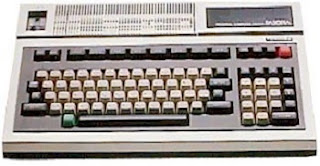This special is a break from the norm for this blog as this is not actually my 'retro' at all, it's somebody else's. I've never touched a Japanese computer in my life but I've become fascinated recently in the details of their history which was something I was completely in the dark about back in the eighties.
I was only aware of the British machines and a few from America. The most I ever heard about when it came to computers from Japan was something called MSX, which I thought was a Japanese computer which was a similar to a ZX Spectrum.
Like the British Market there were stacks of different computers released in the late 70's and 80's including,.
Like the British Market there were stacks of different computers released in the late 70's and 80's including,.
 |
| Toshiba PASOPIA-7 |
 |
| Bandai Gundam RX-78 |
 |
| Sega SC-3000 |
 |
| Sony SMC-70/70G |
 |
| Casio FP-1100 |
 |
| SORD M-5 |
 |
| Hitachi MB-6892 Level-3 Mark-5 |
 |
| Panasonic JR-200U |
 |
| Samsung SPC-1000 |
 |
| Sharp MZ-80B |
It turned out that three 8-bit computers from three separate companies and three 16-bit computers from those same three companies dominated the home computer market in Japan, with one company being way ahead of the others.
You'd be forgiven for thinking that Sony, Nintendo, Sega, or even Bandai, Hitachi, Pansonic, Casio, Samsung or Toshiba, would be at least one of these companies, but you'd be dead wrong.
The three companies which shared the vast majority of the 8-bit market were NEC, Sharp and Fujitsu who may be more well known to British consumers for their televisions and Hi-Fi systems.
They brought out the NEC PC-8801 (1981), the Sharp X1 (1982) and the Fujitsu FM-7 (1982). Maybe you could compare these to early eighties 8 bit machines popular in Britain, the ZX Spectrum, Commodore 64 and BBC Micro.
You'd be forgiven for thinking that Sony, Nintendo, Sega, or even Bandai, Hitachi, Pansonic, Casio, Samsung or Toshiba, would be at least one of these companies, but you'd be dead wrong.
The three companies which shared the vast majority of the 8-bit market were NEC, Sharp and Fujitsu who may be more well known to British consumers for their televisions and Hi-Fi systems.
They brought out the NEC PC-8801 (1981), the Sharp X1 (1982) and the Fujitsu FM-7 (1982). Maybe you could compare these to early eighties 8 bit machines popular in Britain, the ZX Spectrum, Commodore 64 and BBC Micro.
I'll be talking about these three 8 bit computers in more depth in future Retro Japan Computer Specials, along with the many video games available for them, later this month.
In the late eighties the limitations of the 8-bit machines became apparent and users began to shift towards the more powerful 16-bit computers. NEC got a massive head with its PC-9801 (1982), which had been around a while as a popular business machine and had strong links with various 3rd party software developers. But both Sharp and Fujitsu released a couple of great machines themselves in the Sharp X68000 (1987) and the Fujitsu FM Towns (1989). These could be compared to the popular 16 bit computers in Britain in the late eighties, The Atari ST, Amiga 500 and the Acorn Archimedes.
In the late eighties the limitations of the 8-bit machines became apparent and users began to shift towards the more powerful 16-bit computers. NEC got a massive head with its PC-9801 (1982), which had been around a while as a popular business machine and had strong links with various 3rd party software developers. But both Sharp and Fujitsu released a couple of great machines themselves in the Sharp X68000 (1987) and the Fujitsu FM Towns (1989). These could be compared to the popular 16 bit computers in Britain in the late eighties, The Atari ST, Amiga 500 and the Acorn Archimedes.
To compete with the PC-9801 Sharp marketed their X68000 as a powerful arcade level gaming machine appealing to hardcore gamers and Fujitsu marketed their FM-Towns as a flashy and versatile machine appealing to families and schools. This all made for the appearance of a diverse range of video games appearing on these machines which, again, I will look at in more depth in later Retro Japan Computer Specials this month.
If, like me, you never got the chance to play any of the games on these fantastic Japanese machines, especially the exclusive titles rarely released outside of Japan, there are a bunch of emulators you can use on a PC to get your Retro Japan fix.
You can either search the internet for the emulator name or use the links to get what you need.
NEC PC-8801 - PC88Win, M88, X88000
Sharp X1 - Xmillennium
Fujitsu FM-7 - Xmillennium
NEC PC-9801 - Anex86, Neko Project 2, T98-Next
Sharp X68000 - WinX68k, XM6
Fujitsu FM Towns - Unz
If, like me, you never got the chance to play any of the games on these fantastic Japanese machines, especially the exclusive titles rarely released outside of Japan, there are a bunch of emulators you can use on a PC to get your Retro Japan fix.
You can either search the internet for the emulator name or use the links to get what you need.
NEC PC-8801 - PC88Win, M88, X88000
Sharp X1 - Xmillennium
Fujitsu FM-7 - Xmillennium
NEC PC-9801 - Anex86, Neko Project 2, T98-Next
Sharp X68000 - WinX68k, XM6
Fujitsu FM Towns - Unz
On another note be sure to check out my other blog My CAVE 33 which is having it's own Retro Japan Computer Special showing various adverts for hardware and software from eighties Japanese computer magazines.
The next Retro Japan Computer Special will look at the NEC PC-8801 released way back in 1981.
The next Retro Japan Computer Special will look at the NEC PC-8801 released way back in 1981.


No comments:
Post a Comment